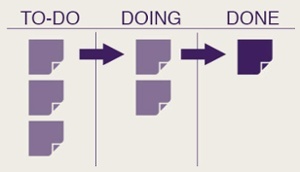 One of the great things about working at KaiNexus is that our team has lots of insightful conversations with customers, prospects, consultants, trainers, and others interested in the tools and techniques associated with continuous improvement. We often get together and share notes on what topics are trending and what information people in the field are looking for.
One of the great things about working at KaiNexus is that our team has lots of insightful conversations with customers, prospects, consultants, trainers, and others interested in the tools and techniques associated with continuous improvement. We often get together and share notes on what topics are trending and what information people in the field are looking for.
Lately, the subject of Kanban and Kanban boards has come up quite a bit. We think this is driven by a larger trend toward visual management and dashboards for all business functions. It’s clear from our conversations that people have questions about how Kanban fits into a well-managed improvement culture.
We can’t claim to have all of the answers, but here are a few of the most important.
What is Kanban?
The Japanese term “Kanban” translates to “signboard” or “visual signal.” It is a visual system for monitoring the flow of work from the start to finish. It was developed by Toyota in the 1940s to create the ability to produce work just-in-time, limit inventory, and make the flow of parts and labor more efficient. Kanban cards were used to signal when inventory needed to be replenished on the factory floor and when more parts needed to be ordered from suppliers. It resulted in lower costs, faster production times and improved quality.
Kanban cards are still used in manufacturing and other industries, but the idea has also been adapted for other types of work. Kanban boards, which show any work in progress are now quite common. It may be a software release moving from development, through QA, to production, or a marketing campaign progressing from concept to launch. In any case, cards or software is used to track work as it moves toward completion.
What are the principals of Kanban?
The guiding ideas of Kanban are:
- Visualize workflow. Whether cards are used in the places where inventory is stored, or a Kanban board is used to track the flow of work, the goal is to create a visual cue that signals the current state and is unambiguous. The goal is to make any disruptions in the flow of work immediately obvious.
- Limit work in progress. If you think of the flow of work as items moving through a pipe, you realize that stuffing more in the top of the pipe does not guarantee more will come out the end. In fact, too much work in progress causes blockages and reduces process efficiency. Kanban boards show all work in progress, so it is easy to tell if the system is becoming overwhelmed at any given point.
- Focus on flow. The movement of work through the “pipe” should be smooth and consistent. Any interruptions in flow require immediate attention.
- Continuous improvement. Users of the Kanban approach continuously seek ways to even out flow, speed production, and improve process quality results.
Why are digital Kanban boards becoming more popular?
It’s 2018, so it stands to reason that people have taken the idea of Kanban boards into the cloud. But, aside from just following the digital trend, there are some very legitimate reasons why digital Kanban boards are a great idea. The advantages include:
- An unlimited repository for knowledge. A physical Kanban board or system can only show a limited number of processes or projects. That’s why it usually shows current work in progress. However, the history of completed projects is useful to capture and can help teams get smarter with each cycle. A digital Kanban board allows you to capture all of that history and retain those lessons for future reference.
- Anytime, anywhere access. Modern workforces are distributed. A cloud-based Kanban solution makes it easy to keep everyone engaged, no matter where they happen to be. They can also update the system any time of day, making sure that visual management remains real-time.
- Faster problem resolution. When there is an identified blockage in flow or an indication that too much work is in progress, a digital Kanban system gives you the ability to immediately start a project to identify the root cause and solve the problem. Users can make assignments, set up notifications and alerts and enjoy a proactive solution that ensures the problem gets solved quickly.
Digital Kanban boards as a feature of improvement management software are an excellent example of a modern spin on a decades-old idea. They give teams the best of Lean management thinking and today’s software capabilities. Hopefully, these answers have inspired you to learn more.



Add a Comment